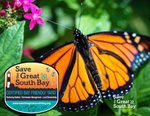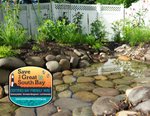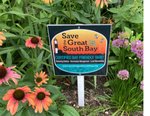


Long Island invented the suburban lawn. Fields of green with ornamental bushes brought in from all over the world. All manner of care was required—watering, fertilizing, pesticides—so that these exotics and plants from other climates could survive here. But this search for artificial “perfection” came with a heavy price, especially for local wildlife and the ecosystem services provided by our bays. Local waters, tainted in part by lawn runoff, are on their way to becoming lifeless. Populations of insects, including many pollinators, as well as crustaceans, mollusks, birds, fish, amphibians, and reptiles, have been decimated. It’s time to move from the 1950s to a future we want for our local environment, for the Great South Bay.
What is a bay-friendly yard? They are lawns, or simply sections of your yard, with a composition of native trees, bushes, shrubs, and grasses that help filter nitrogen, manage stormwater, and create the ecosystems necessary to support local birds and insects, particularly pollinators such as bees and butterflies. They are rich, colorful landscapes that can look meadow-like or be more manicured, but require little extra water, and no chemicals or pesticides, because they belong here. In addition, the complex, intertwined root systems of the native plantings and the rich biome they create through leaf litter and soil accretion, means cleaner water for a healthier bay.
How does one create a yard that is bay-friendly? By incorporating these three essential elements:
1. Habitat Restoration
There is no piece of land too small to make a difference, and it can have either a natural or more manicured look. Examples of habitat restoration include: identification and removal of invasive species, planting of native plant species, or reducing lawn area. What you plant depends on your soil type—inland yards tend to have drier soils; coastal waters naturally tend to have damper soils.
2. Stormwater Management
Stormwater runoff, and the damaging nutrients and chemicals that it contains, continues to degrade the Great South Bay. A bay-friendly yard is one that endeavors to maintain stormwater onsite. Techniques include the use of rain barrels, rain gardens, permeable pavers/pavement, and planting native plants that require little to no additional irrigation.
3. Local Stewardship
We prefer the term “stewardship” to yard maintenance. An obvious step one can take is to eliminate the wasteful and damaging practice of the application of pesticides or fertilizers. Instead, try mulching your leaves in the fall and allowing them to fertilize your yard over the winter. Mow less often and use a mulching blade where you can—every two weeks is fine, and your lawn won’t grow out of control. Continuous monitoring and removal of invasive plants also constitutes good stewardship.
Comments
No comments on this item Please log in to comment by clicking here